We've independently reviewed this article to make sure it's as accurate as we can make it.
To find out more about our article creation and review process, check out our editorial guidelines.
Unless you have a particular fondness for mopping your laundry room floor often, a washer that won’t stop filling with water is a major inconvenience.
There are a few reasons why you’re having washer water problems, but luckily, the fixes for the most common causes are very easy. Before you have to get the mop out again, let’s figure out what’s causing the water level issues.
Ready? Let’s dive in!
Why trust us? This article was written by Craig Anderson and James Blackford.
Craig has helped thousands of other homeowners repair their appliances since 2016.
James is one of our resident appliance experts, with over 16 years of experience. He currently works as a Master Technician for SquareTrade, and runs his own appliance repair business.
Washing Machine Mechanics Basics
Every washing machine is different in little ways, but the basic mechanics are the same no matter what brand you opt for. Knowing how the appliance works can help you repair it.
When it comes to water issues, a few components are typically at fault. Let’s review what a couple of your washing machine’s key parts do and where they can be located.
Water Inlet Control Valve
The water inlet control valve works closely with the 2 hoses at the back of your washing machine. Together, the inlet control valve and the hoses bring hot or cold water into the unit, depending on what the wash calls for.
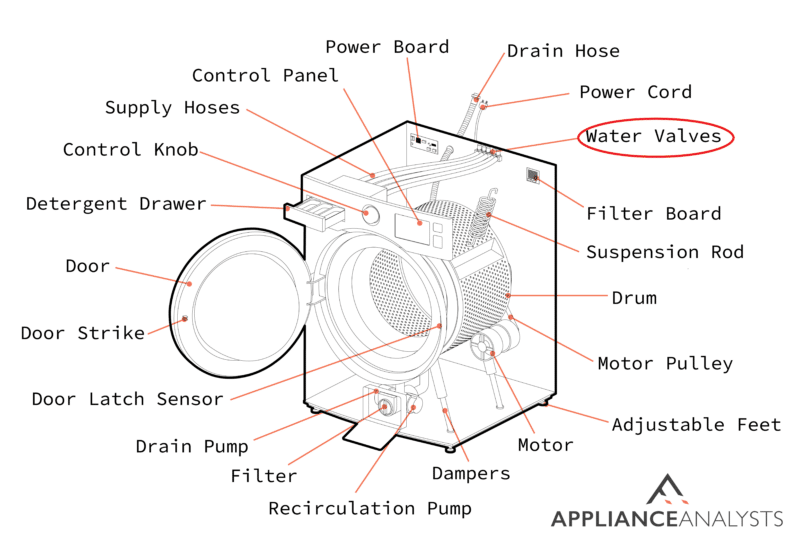
You can think of the valve as the bouncer or security staff at the door of a club – water doesn’t get in unless the valve says so.
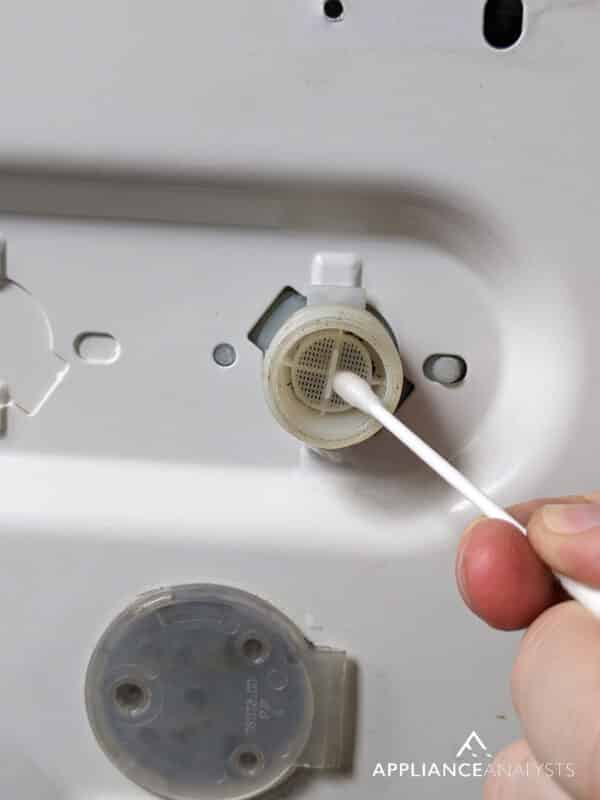
The water inlet control valve has two threaded ports that the hoses screw into. The control valve receives its orders from the water level switch, which we’ll get to in the next section.
If your washer keeps filling up with water, the issue could likely be related to the water inlet control valve not controlling incoming water.
Water Level Switch
The water level switch in your washing machine lets the water inlet control valve know when the tub has enough water for the job.
There are different types of water level switches. Most of today’s washing machines utilize a pressostat or a pressure switch. The pressure switch is connected to a hose that leads to the body of the washer. As water fills, air moves through the hose towards the switch, applying pressure.
When enough pressure is applied, the switch sends the order to turn off the water.
You will need to consult your machine’s manual to locate the switch in your washer.
From what I’ve seen after working on hundreds of washing machines over the years, the pressure switch will be found under the top panel. At least, that’s the case for front-load washers.
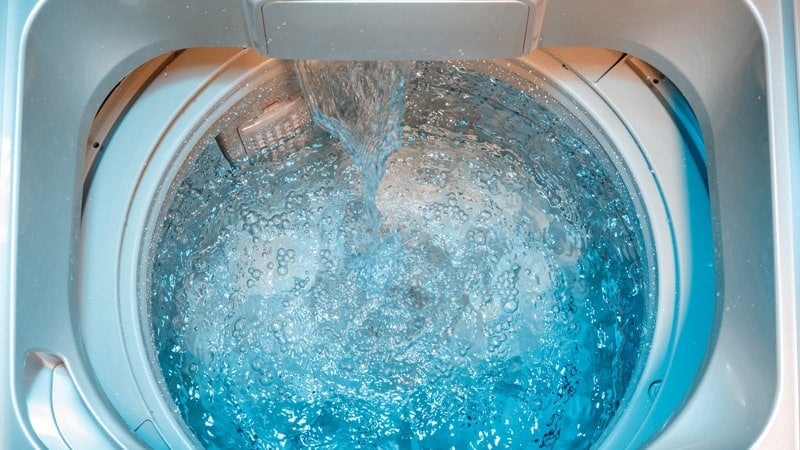
Why Your Washer Keeps Filling With Water
Now that you know some of the critical components of your washer, let’s talk about the actual potential causes and solutions for when your washing machine keeps filling with water.
#1 Check the Water Inlet Control Valve for Clogs
Clogs in your washer’s inlet control valve are one of the most common reasons it fills with water. To address the clogs, you first want to remove the hoses from the washer’s body. After removing the hoses, check the valve’s ports for any clogs.
Try to spot any limescale, lint, or residue of any kind. Bear in mind that if you haven’t cleaned the valve in a while, the debris could have an unpleasant smell. My usual advice is to clean the valve, filters, and ports at least twice yearly.
You should see a small screen inside the ports, which works as the ports’ filters. If the filters look dirty, you’ll need to clean them.
The filter screens are delicate and cannot be replaced, so please be very careful. Damaging a screen requires replacing the entire control valve. Here’s my favorite filter-cleaning method:
- Using needle nose pliers, remove the filter screen as gently as possible.
- Place the screen in your palm and try to brush away any sediment you see.You can try a small brush, like a toothbrush if it’s stubborn.
- If the dirt isn’t going anywhere, you can soak the screens in a mixture of water and vinegar. After a short time, you should be able to brush away the debris. Once the screens are clean to your satisfaction, please place them in the ports again.
#2 Check the Water Inlet Control Valve’s Solenoids
Another reason your washer keeps filling with water could be that the water inlet control valve’s solenoids are failing. Long story short, a solenoid is a name for an electricity-powered valve. If your washing machine has water issues, your valve might not be getting enough power.
To test the power of the valve on your washer, you’ll need a device called a multimeter, which measures continuity. You can purchase a multimeter at any hardware store. Most are less than $20.
To gauge the valve’s power, remove it from your washing machine. Touch the two test prods to the coil inside the valve’s terminals using the multimeter. YouTube videos make it easy if you aren’t sure how to use a multimeter.
When you test the solenoid, the multimeter should detect a level of resistance. If the multimeter gives a reading of zero, your water inlet control valve has failed and needs to be replaced.
To replace the valve, consult the owner’s manual for your machine so you can be sure to purchase the proper model.
#3 Test the Water Level Switch
If your washer keeps filling with water, you should turn your attention to the water level switch. In the description of the component above, it was mentioned that the switch is attached to a hose. The hose must be in good working order to detect the water level.
Once you’ve located the switch, please remove it from the hose. Take a good look at the hose. Any holes or tears will prevent the air in the hose from ever reaching the switch. If the hose is damaged, I’d recommend replacing it.
No holes? Great! Now, check the inside of the hose. Is it clogged? Any clog would interfere with an accurate reading of the water level. Fortunately, the hose won’t need to be replaced over a clog – cleaning it is often more than enough.
You may have an electrical issue if the hose passes the visual inspection. If you still have the multimeter from the last step, you’ll also want to test the resistance level in the water level switch. Like with the valve, if the readings indicate no resistance, the switch will need to be replaced.
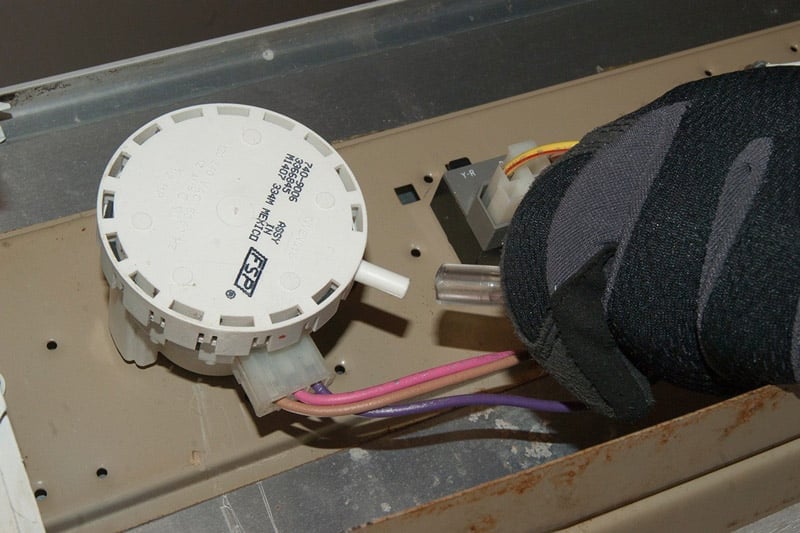
If you want to get any replacement part – or see how much one would cost – click to enter your model number in the search bar below. Our partners at AppliancePartsPros stock almost every part with free guides on how to install them.

#4 Check Your Water Pressure
An overfilling washer could mean a water pressure issue in your home overall.
The motion of water is called flow. Water naturally flows downward. Water pressure, or the weight of water moving downward, determines how fast the water goes. Simply put, the heavier the water is on top, the quicker it will all flow.
Ask yourself the following. When you take a shower, is the water pressure weak or strong? Most people hate low water pressure, and so do washers!
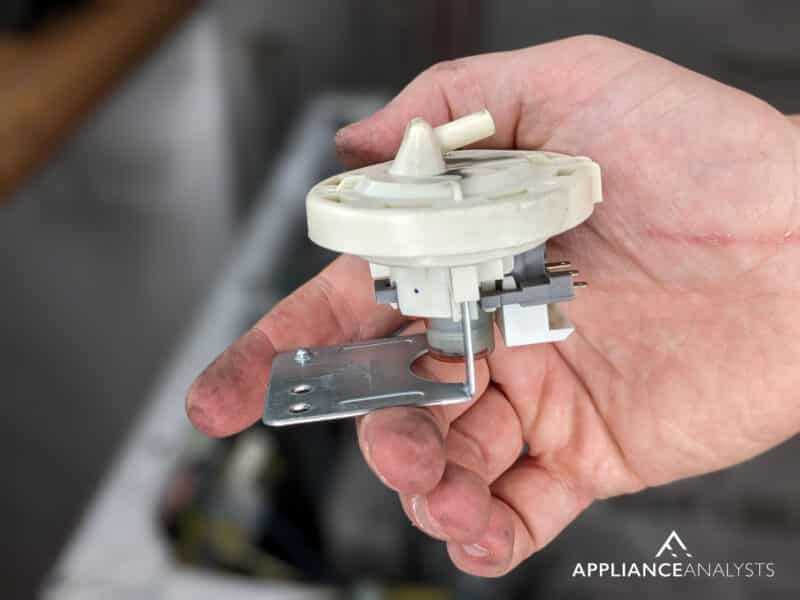
Decades ago, washing machines depended on a motor that switched on at a certain water level. When the level was achieved, on went the motor.
Today, your washing machine is a portrait of efficiency and convenience – if the water pressure is just right. Your appliance is full of software that keeps it in working order.
One such program tracks how long the water takes to fill the tub. If the water pressure is too low and it takes too long to fill the basin, the software will abort the mission, so to speak.
You can purchase a water pressure gauge for an accurate reading of your home’s water pressure. The water pressure gauge threads onto your outdoor hose for its reading. You have low water pressure if you get below 40 pressure per square inch (PSI).
How do you increase your home’s water pressure? Unfortunately, boosting the pressure isn’t simple. You can buy a water booster system to increase the water pressure. However, water booster systems are expensive, and installation shouldn’t usually be done without professional help.
Conclusion
When it comes to washing clothes, some water is necessary. However, when too much water starts to cause a filling issue, your washer needs attention. Ideally, getting everything back to normal will be quick and smooth. And even if it’s not, you should now know how to take on many washer issues.
Thank you very much for sticking with me all the way to the end. If this article was useful and informational, please consider checking out our other incredible resources below and subscribing to our newsletter.
Have a wonderful day!
-Craig.








